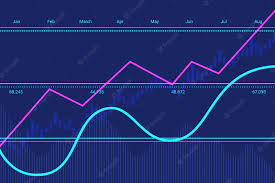Bar patterns are formations that appear on price charts and provide valuable insights into market trends and potential reversals. By recognizing these patterns, traders can make informed decisions and improve their trading strategies. In this article, we will explore seven bar patterns that every trader should be familiar with.
7 Bar Patterns that Traders Should Be Aware Of Bar patterns occur over a short period and help determine reasonable stop-loss locations and times for our transactions.
Every price action trader need to be familiar with both candlestick patterns and bar patterns since they are incredibly similar to one another.
It is vital to remember that the bar patterns play a significant part when they emerge toward the end of a strong uptrend or downturn when the trend is nearing its conclusion.
In the same way as candlestick patterns are short-term patterns, bar patterns are also short-term patterns, and they may suggest a change in the direction in that the stock values are moving in.
Bar patterns are versatile and may be used to any timescale, including five minutes, fifteen minutes, an hour, a day, a week, a month, etc.
The significance of bar patterns in determining the size of the next move rises in direct proportion to the length of the period under consideration.
The following is a list of the seven bar patterns that every price trader needs to be familiar with:
The Reversal of One Bar:
One Bar Reversal is a kind of reversal bar that may also be referred to as the climax, top or bottom reversal bar, or key reversal bar.
When the price begins lower than the low of the preceding bar and then closes higher than that bar’s high, this is a bullish critical reversal bar. On the other hand, a bearish key reversal bar is generated when the price begins higher than the previous bar’s high and closes lower than the low of the preceding bar.
Price gaps are often seen at the beginning of key reversal bars. Because gaps may only be found in intraday time frames very seldom, the majority of critical reversal bars are generated in the daily and higher time frames.
A gap or an opening gap often precedes it, and the bar’s duration is not as intense as that of a spike.
At the bottom, we see this pattern repeated in a backwards order. Following the development of the bar, there will be a sequence of higher highs or lower lows, whichever occurs first. This will demonstrate that a reversal to either direction has taken place.
Two-Bar Reversal
The two-bar reversal, sometimes referred to as the Pipe formation, is a pattern that appears at the conclusion of a trend, regardless of whether it was an upward or a downward trend.
In the bottom bar pattern, the first bar typically closes in the lower half of the bar, suggesting a bearish bar, while the second bar typically closes near its high, indicating a bullish bar. Both of these closing positions are considered to be indicative of a bar that is bearish.
In the top bar pattern, the first bar often closes near its high, suggesting that it is bullish, while the second bar typically closes near its low, indicating that it is a bearish bar. This indicates that the pattern is likely to continue in a positive direction.
In most cases, a high volume may be visible in both bars, however it is preferable to have a larger volume in the bar on the left rather than the bar on the right. The length of the second bar need to be somewhat increased compared to that of the first bar.
Horn Design
This pattern is essentially identical to the pipe pattern, with the exception that a shorter bar is used to divide the two longer bars in the pattern.
The horns consist of the two lengthy bars that are in the middle. This formation is more dependable with weekly bars and shares the properties of the pipe with its counterpart.
Inside Bar:
An inside bar is a bar with a narrow range than the range of the bar that came before it. This is a pattern that is analogous to the Harami candlestick pattern.
When this pattern is produced near the conclusion of an uptrend or downturn rather than in a congestion region, it is more dependable than when it forms in the middle of the congestion area.
In most cases, the initial bar will have a greater volume than the second bar, despite the fact that the volume will grow as the successive bars are created whenever there is a short term reversal.
After a drop in price, a bullish inside bar will appear on the chart. This will be indicated by the first bar being a tall bar with the closing price being lower than the opening price, and the second bar appearing within the range of the first bar with the closing price being higher than the opening price.
In a similar fashion, a bearish inside bar is formed after an uptrend when the first bar is a tall bar with a closing price that is higher than the opening price and the second bar is within the range of the first bar and has a closing price that is lower than the opening price. Both bars are considered to be inside the range of the first bar.
Outside Bar:
The Outside Bar is a kind of bar similar to the Engulfing candlestick pattern in that it has a range greater than the range of the bar that came before it.
When this bar pattern appears towards the conclusion of an uptrend or downturn rather than in a congestion region, it is a more trustworthy indicator of future price movement.
In most cases, the initial bar will have a greater volume than the second bar, despite the fact that the volume will grow as the successive bars are created whenever there is a short term reversal.
After a drop in price, a Bullish Outside Bar will appear on the chart. The first bar will be short and have a closing price that is lower than the opening price, while the second bar will be tall and have a closing price that is higher than the starting price.
A Bearish Inside Bar is a pattern that appears after an uptrend and consists of two bars: the first bar is a short bar with a closing price that is higher than the opening price, and the second bar is a tall bar with a closing price that is lower than the opening price. In this pattern, the first bar closes at a higher price than the opening price.
Narrow Range 7:
The development of this bar pattern needs the completion of seven bars, and the last bar in the sequence has the narrowest bar range of all the bars in the series.
Similar to the inner bar, this pattern implies a decrease in the underlying volatility. The NR7 pattern is a stronger indicator of reducing volatility than just one pattern alone because the reduced volatility occurs within the context of seven bars rather than just one pattern.
The NR7 pattern may drift upwards or downwards, signaling a price surge with diminishing volatility. This contrasts the inner bar, which does not exhibit any strength in any direction.
The NR7 alerts traders to potentially explosive market movements when the range fluctuates between range contraction and expansion.
Three Bar Reversal
Forming a three-bar reversal pattern indicates a change in the prevailing trend.
The three-bar reversal bar is the most cautious of the different reversal patterns since it spans three bars and the third bar indicates that the market has altered its direction. This is because the three-bar reversal bar extends longer than the other reversal patterns.
One need to make purchases just above the most recent bar in the bullish pattern, and one ought to make sales just below the most recent bar in the bearish pattern.
Conclusion
Understanding and recognizing bar patterns is an essential skill for traders. By identifying these patterns on price charts, traders can gain insights into market sentiment, potential reversals, and trading opportunities.
it is essential to remember that the suggestions provided by these bar patterns should be corroborated with other technical indicators such as moving averages, relative strength index, and so on.
Analysis of volume need to be a standard part of the trading techniques used in conjunction with these bar patterns. This is because volume comes before price and confirms the signals created by these bar patterns.
How reliable are bar patterns for making trading decisions?
Bar patterns can provide valuable information, but they should be used with other forms of analysis and confirmation from additional indicators or price action.
Can bar patterns be used in isolation for trading decisions?
It is recommended to use bar patterns in combination with other technical analysis tools, such as trendlines, support and resistance levels, and indicators, to validate trade signals and improve accuracy.
Can bar patterns be used in any financial market?
Yes, bar patterns can be applied to various financial markets, including stocks, forex, commodities, and cryptocurrencies.




